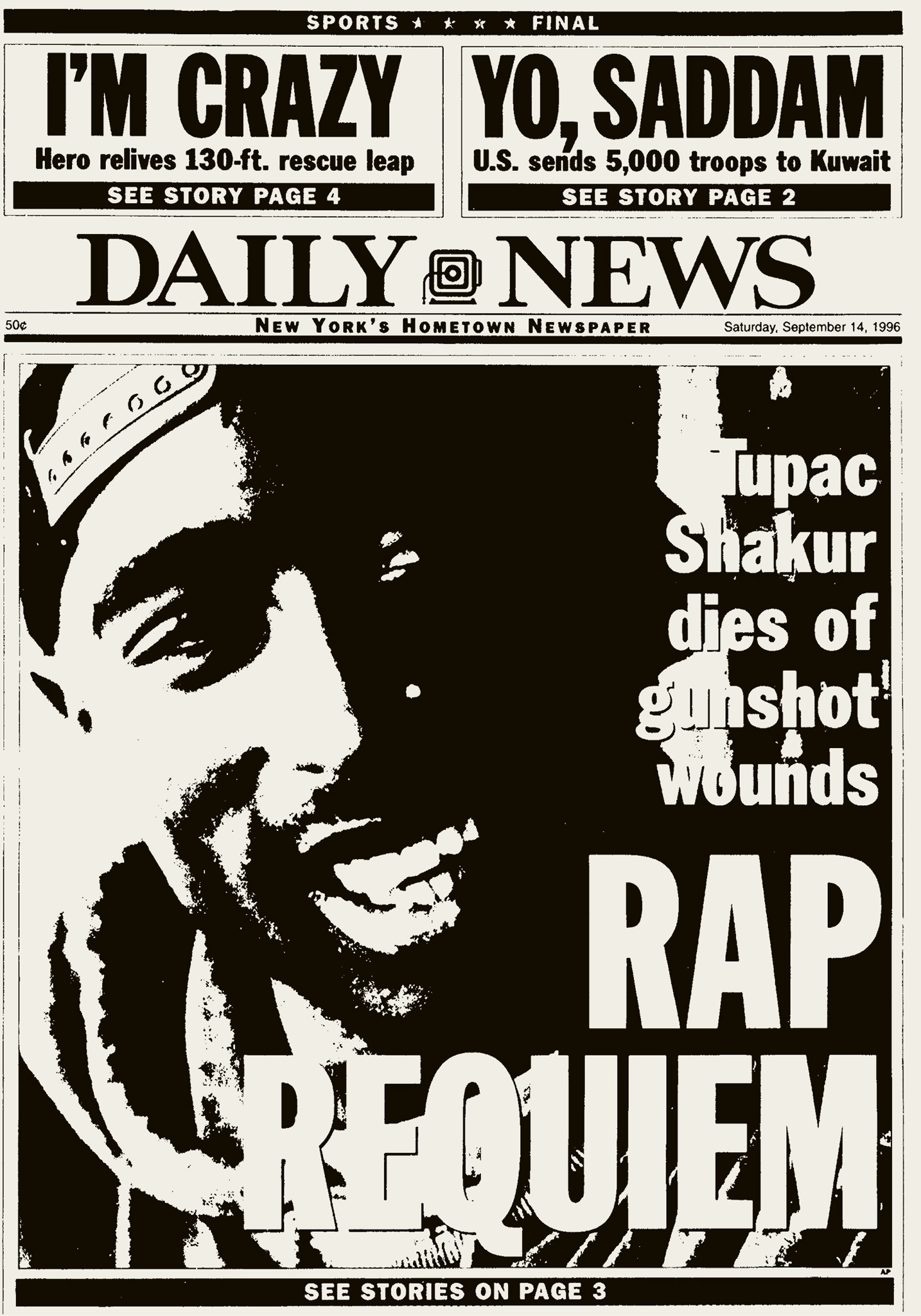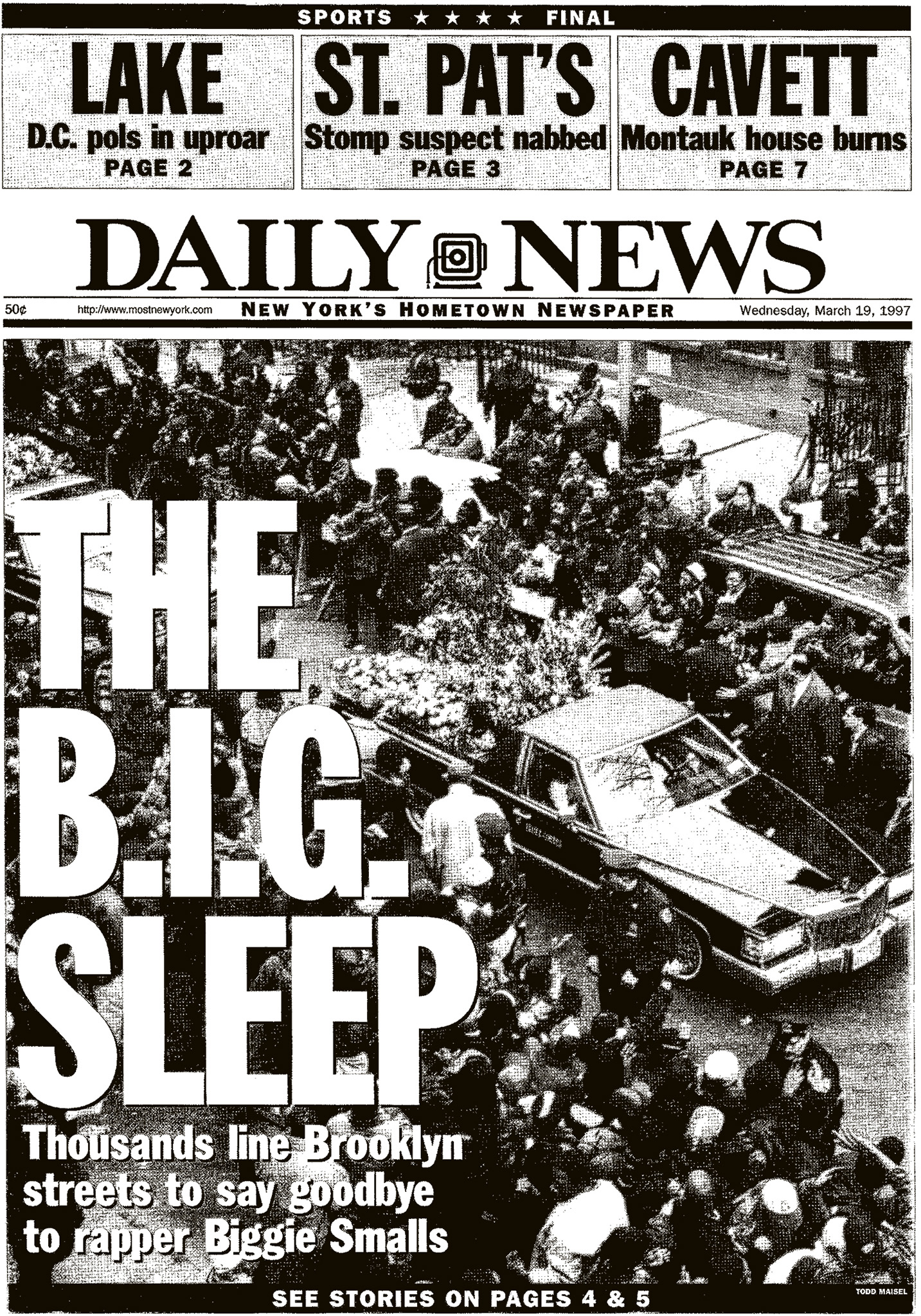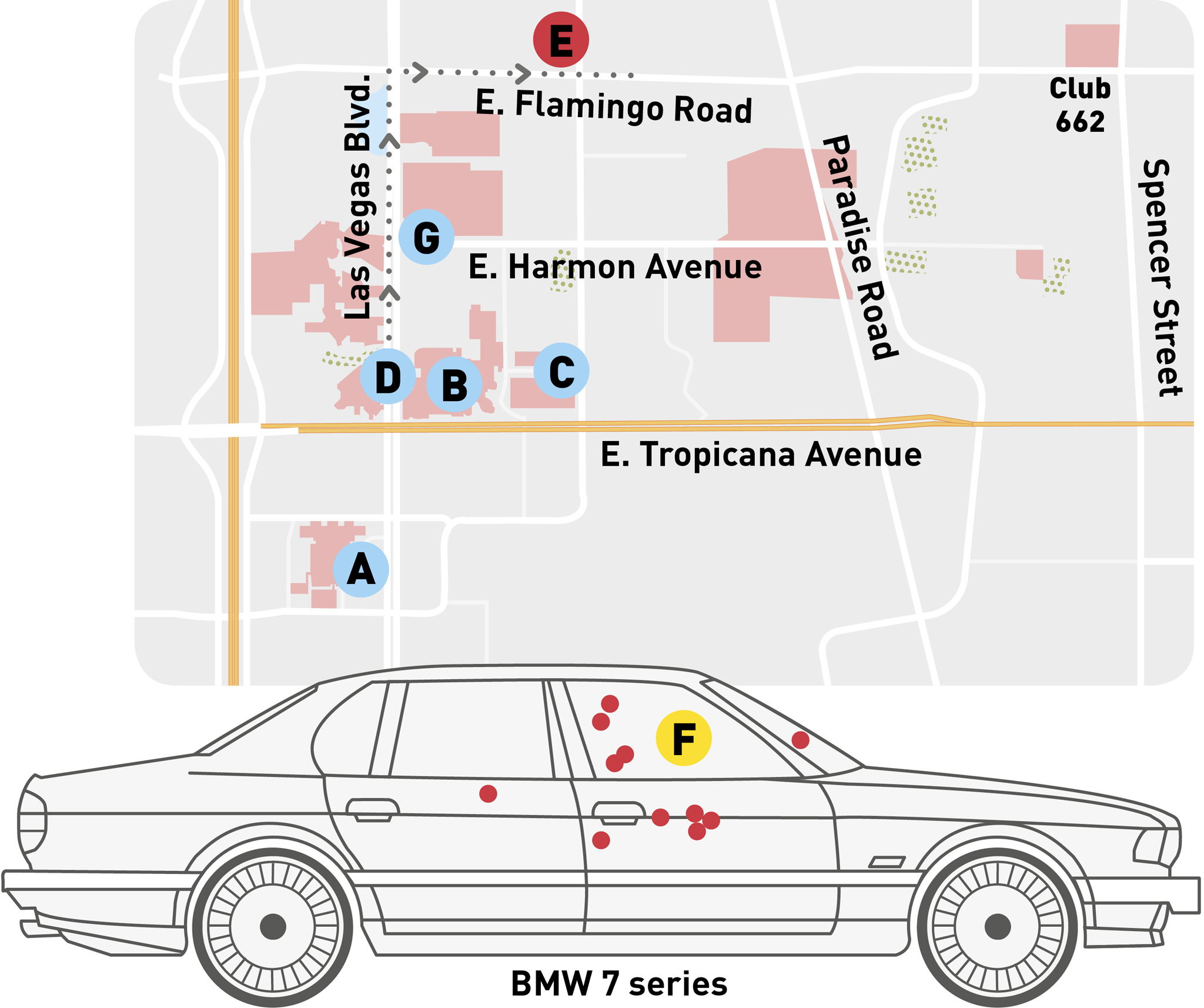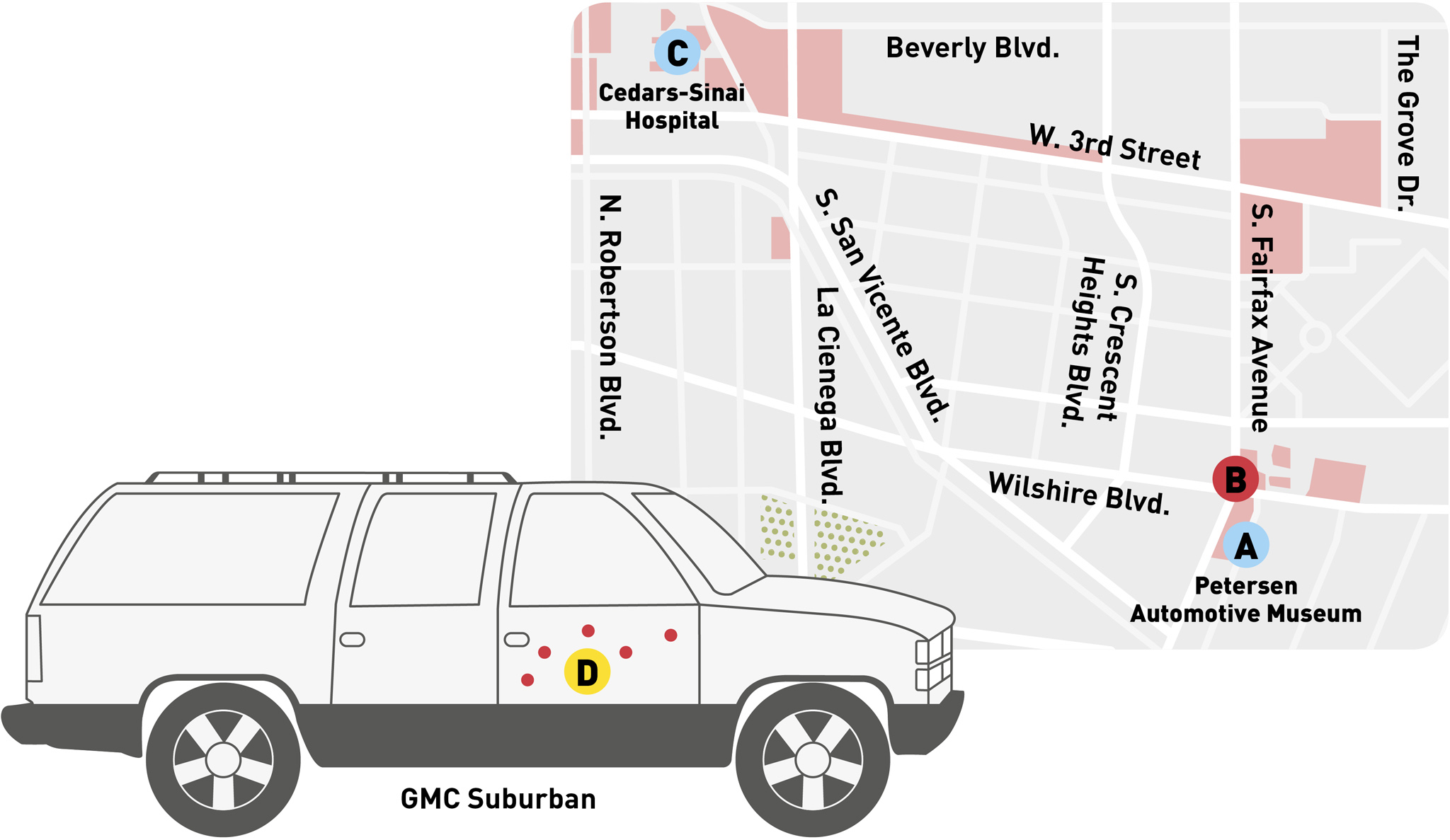TUPAC SHAKUR AND BIGGIE SMALLS, 1996–97
DRIVE-BY SHOOTINGS
Rap megastars Tupac Shakur and Biggie Smalls were friends who became the bitterest of rivals. Their deaths sparked the most infamous murder mystery in hip-hop history…
Tupac Shakur and Biggie Smalls were two of the leading rap artists of the 1990s and remain among the most influential of all time. Their staggering fame and success was rapidly rising—until both were killed in drive-by shootings. On September 7, 1996, Tupac Shakur, aged just 25, was gunned down in his car in Las Vegas and died from his wounds six days later. Just months later, on March 9 the following year, 24-year-old Christopher Wallace, better known as Biggie Smalls or The Notorious B.I.G., was shot dead in his car outside a Los Angeles party. The investigations that followed would reveal a grim insight into gang rivalries, greed for money, and dangerous grudges.
Tupac and Biggie were key players in the East Coast-West Coast hip-hop rivalry. This was principally between the competing record labels Bad Boy Records (owned by Sean Combs, a.k.a. Puff Daddy) and Death Row Records (owned by Marion “Suge” Knight). The feud sparked bitter tension between rappers, fans, and LA gangs, with the Crips backing Bad Boy Records and the Bloods backing Death Row Records. Tupac and Biggie had been friends early in their careers. However, in 1994 Shakur was ambushed and shot five times in Manhattan, and he accused Biggie of being involved in it. Some say it was this incident that launched the rift that would ultimately claim the lives of both artists. Following various accusations, Biggie responded by releasing songs with veiled references to the shooting, while Shakur released “Hit ’Em Up,” the lyrics of which bragged that he had slept with Biggie’s wife, the singer and songwriter Faith Evans.

Clockwise from top: Tupac Shakur performs onstage in March 1994 in Chicago, Illinois; The Notorious B.I.G., a.k.a. Biggie Smalls, outside his mother’s house in Brooklyn, New York City; CEO of Death Row Records Marion Suge Knight at Los Angeles Superior Court, following the hearings on the murder of Tupac Shakur.
THE MURDER OF TUPAC
On September 7, 1996, Tupac attended the Mike Tyson vs. Bruce Seldon boxing match at the MGM Grand in Las Vegas. After they left, Suge Knight drove Shakur to a party at Club 662, with the rest of Tupac’s entourage following in cars behind them. When Knight stopped at a traffic light, a white Cadillac pulled up alongside their black BMW, and more than a dozen shots were fired from a .40 Glock 22 semiautomatic pistol, mortally wounding Tupac and grazing Knight’s head. Tupac had been hit twice in the chest, once in the arm, and once in the thigh.
September 13, 1996 / Tupac Shakur dies from his injuries.
The police investigation into Tupac’s murder was plagued by a lack of evidence and fearful, uncooperative witnesses. Despite the fact that numerous people were nearby when the shooting occurred, apparently nobody saw a thing. A friend of Tupac’s who had been there that night, Yaki Kadafi, said that he could identify the assailant. Unfortunately, he was accidentally shot dead just two months after Tupac, before the police were able to interview him about the case.
The first person of interest in the shooting was a Southside Crips gang member named Orlando Anderson, who had been seen fighting with Tupac in the MGM Grand lobby shortly before the shooting. Suge Knight’s friend, Travon Lane, had identified Anderson as the person who had robbed him of his Death Row Records chain a few weeks earlier. Tupac and other members of Death Row Records promptly beat Anderson up. When Tupac was ambushed in a drive-by shooting later that night, Anderson naturally became the prime suspect. He was arrested and questioned on October 2, 1996, but police released him without charge two days later.
THE MURDER OF BIGGIE
The music world reeled with grief following the shooting of Tupac, but it would not be long before fans were mourning another shocking murder. At around 12:35 a.m. on March 9, 1997, Biggie Smalls climbed into the passenger’s seat of his GMC Suburban. He was leaving a Soul Train Awards afterparty hosted by Vibe magazine at the Petersen Automotive Museum in Los Angeles. As the car came to a halt at a red light, a dark green (or black, depending on the witness) Chevy pulled up alongside. At least seven rounds from a 9mm pistol of unknown make were fired though the door of Biggie’s car and the closed tinted window, hitting only Biggie. It was clearly an assassination, with the killer having a specific target in mind. Biggie was rushed to nearby Cedars-Sinai Hospital, but was pronounced dead at 1:15 a.m. He had been hit by four bullets. The fatal shot struck his right hip, traveling up to his vital organs, including both his heart and his lungs. Death was almost instantaneous.
“BIGGIE HAD TO BE CRAZY TO BE SO UNPROTECTED, IN LOS ANGELES, SIX MONTHS AFTER TUPAC.”
LAPD OFFICER
This professional drive-by hit mirrored the earlier slaying of Tupac Shakur and the LAPD soon announced that, in their opinion, the murder was motivated by revenge. “The conventional wisdom is, you know, it’s got to be payback for Tupac,” an officer commented.1 Many rap aficionados agreed that the murders were a result of the long-running feud between the East Coast and West Coast, while others speculated that the feud could be a veil to hide a more complex motivation.
THE ROLE OF SUGE KNIGHT
Nick Broomfield’s 2002 feature-length documentary, Biggie & Tupac, put forward the case that Suge Knight ordered Tupac’s murder because Knight owed the rap star a large sum of money in royalties, and he had heard through the grapevine that Tupac was planning to switch to another record label. According to Broomfield, the murders of both Shakur and Biggie were orchestrated by Suge and then carried out—and covered up—by the LAPD. He alleged that, at the time of the murder, Knight had several LAPD officers on his payroll working as off-duty bodyguards. In the documentary, a former LAPD detective named Russell Poole reports that his own private investigation into Suge Knight’s role in the murders of Tupac and Biggie was rebuffed. He believed that his superiors were engaged in a cover-up and resigned from his job. Randall Sullivan, author of LAbyrinth,2 also presented a case against the Death Row Records boss. He claimed that Knight had Biggie murdered to maintain the illusion of a tit-for-tat feud and divert suspicion from himself for Tupac’s murder.
“IF THIS HAD BEEN SOME ORDINARY DRIVE-BY SHOOTING BY SOME INEXPERIENCED GANG-BANGERS, WE WOULD’VE SOLVED IT A LONG TIME AGO.”
FORMER LAPD DETECTIVE RUSSELL POOLE
In 2005, Biggie’s family filed a wrongful-death lawsuit in which they contended that ex-LAPD officer, David Mack, helped to plan Biggie’s shooting. Mack, who by then was serving a 14-year prison sentence for bank robbery, denied any involvement. Kevin Hackie, Tupac’s former bodyguard, was called as a witness. He testified that Mack and employees of Death Row Records—including Suge Knight—orchestrated the murder. He stated that he once heard Death Row Records’ head of security and LAPD officer Reggie Wright Jr. say that they were going to “get” Biggie in retaliation for Tupac’s murder. However, the wrongful-death lawsuit was dismissed.
BIGGIE’S CRIME?
Another widely popular theory is that it was in fact Biggie Smalls who ordered the hit on Tupac Shakur during the escalating East Coast vs. West Coast feud. Los Angeles Times reporter Chuck Philips wrote an article in which he claimed that Biggie was in Las Vegas at the time of the shooting and that he supplied the gun and a $1 million bounty for the murder of Tupac, which was carried out by the Crips in revenge for the beating of Orlando Anderson. However, further investigation revealed that Biggie was in a New York recording studio at the time of the murder. Philips would later write another report in which he alleged that Biggie was involved in an earlier shooting of Shakur in New York in 1994. This report claimed that Biggie—along with Sean Combs and Czar Entertainment CEO Jimmy “Henchman” Rosemond—orchestrated the attack in response to perceived disrespect by Tupac. Both Combs and Rosemond strongly denied any involvement, saying that the “story is beyond ridiculous and is completely false.” They added that they had never even been questioned in regard to the shooting.3 Philips had supposedly received the information from jailhouse informants and in 2011, Dexter Isaac—who was serving time in prison for unrelated crimes—claimed that he had committed the 1994 shooting of Tupac Shakur and that Rosemond had paid him $2,500 to carry it out.
A MATTER OF DEBT
The conspiracy theories and stream of suspects surrounding the two murder cases are seemingly endless. Retired LAPD homicide detective Greg Kading, who worked on both cases, provided yet another theory. In his 2011 book Murder Rap: The Untold Story of the Biggie Smalls and Tupac Shakur Murders by the Detective Who Solved Both Cases,4 Kading maintains that Sean Combs hired Tupac’s assassin for $1 million.
Furthermore, “sources” in a 1998 Vice article alleged that Biggie was killed over unpaid debts of $100,000 owed to the Crips, who had been hired as security by Combs. “Puffy refused to pay the hundred thousand. He offered them ten thousand. That’s why Biggie Smalls is dead today,” said Reggie Wright Jr. (who would later be named as a suspect in the murder of Tupac Shakur by both Suge Knight and then Kevin Hackie during the wrongful-death lawsuit filed by Biggie’s family). Combs responded:“That’s not even possible. I don’t have debts, period.”5
GONE BUT NOT FORGOTTEN
The forever-intertwined murders gave an insight into hip-hop’s murky underworld. The short lives and violent deaths of Tupac Shakur and Biggie Smalls have made them international icons; few pop culture figures have been mythologized and eulogized to the same extent. Spectacular murals paying tribute to both rap artists adorn streets worldwide. Nevertheless, despite all the many articles, books, movies, and theories devoted to the double murder, nobody has ever been charged with either killing. As long as the key players remain tight-lipped, there is little hope of closure anytime soon.
TUPAC SHAKUR SHOOTING
 Tupac arrives at Luxor Hotel
Tupac arrives at Luxor Hotel
 8:00 p.m. Mike Tyson-Bruce Seldon fight at MGM Grand
8:00 p.m. Mike Tyson-Bruce Seldon fight at MGM Grand
 8:30-9:00 p.m. Altercation between Tupac and Anderson
8:30-9:00 p.m. Altercation between Tupac and Anderson
 Tupac & Suge Knight travel toward Club 662
Tupac & Suge Knight travel toward Club 662
 11:15 p.m. Shots fired at Tupac and Knight’s car
11:15 p.m. Shots fired at Tupac and Knight’s car
 Bullet holes
Bullet holes
 Suge Knight makes U-turn back toward Las Vegas Blvd.
Suge Knight makes U-turn back toward Las Vegas Blvd.
BIGGIE SMALLS SHOOTING
 Approx 12:35 a.m. Biggie leaves the Soul Train Awards afterparty
Approx 12:35 a.m. Biggie leaves the Soul Train Awards afterparty
 Shots fired at Biggie’s car
Shots fired at Biggie’s car
 1:15 a.m. Biggie is pronounced dead at Cedars-Sinai Hospital
1:15 a.m. Biggie is pronounced dead at Cedars-Sinai Hospital
 Bullet holes
Bullet holes

The murder of Tupac Shakur—Daily News front page, dated September 14, 1996.

The funeral of Biggie Smalls—Daily News front page, dated March 19, 1997.
CASE NOTES


 Tupac arrives at Luxor Hotel
Tupac arrives at Luxor Hotel 8:00 p.m. Mike Tyson-Bruce Seldon fight at MGM Grand
8:00 p.m. Mike Tyson-Bruce Seldon fight at MGM Grand 8:30-9:00 p.m. Altercation between Tupac and Anderson
8:30-9:00 p.m. Altercation between Tupac and Anderson Tupac & Suge Knight travel toward Club 662
Tupac & Suge Knight travel toward Club 662 11:15 p.m. Shots fired at Tupac and Knight’s car
11:15 p.m. Shots fired at Tupac and Knight’s car Bullet holes
Bullet holes Suge Knight makes U-turn back toward Las Vegas Blvd.
Suge Knight makes U-turn back toward Las Vegas Blvd.
 Shots fired at Biggie’s car
Shots fired at Biggie’s car Bullet holes
Bullet holes
